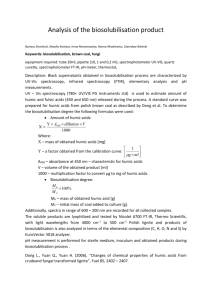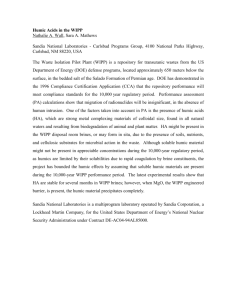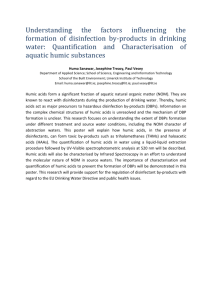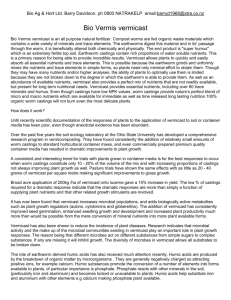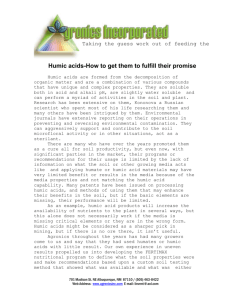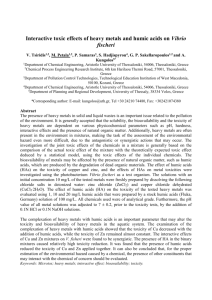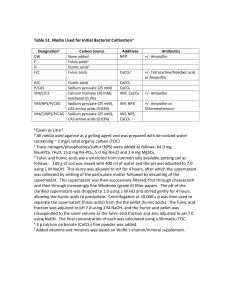Solvation excesses of humic acid in water solutions of urea
advertisement
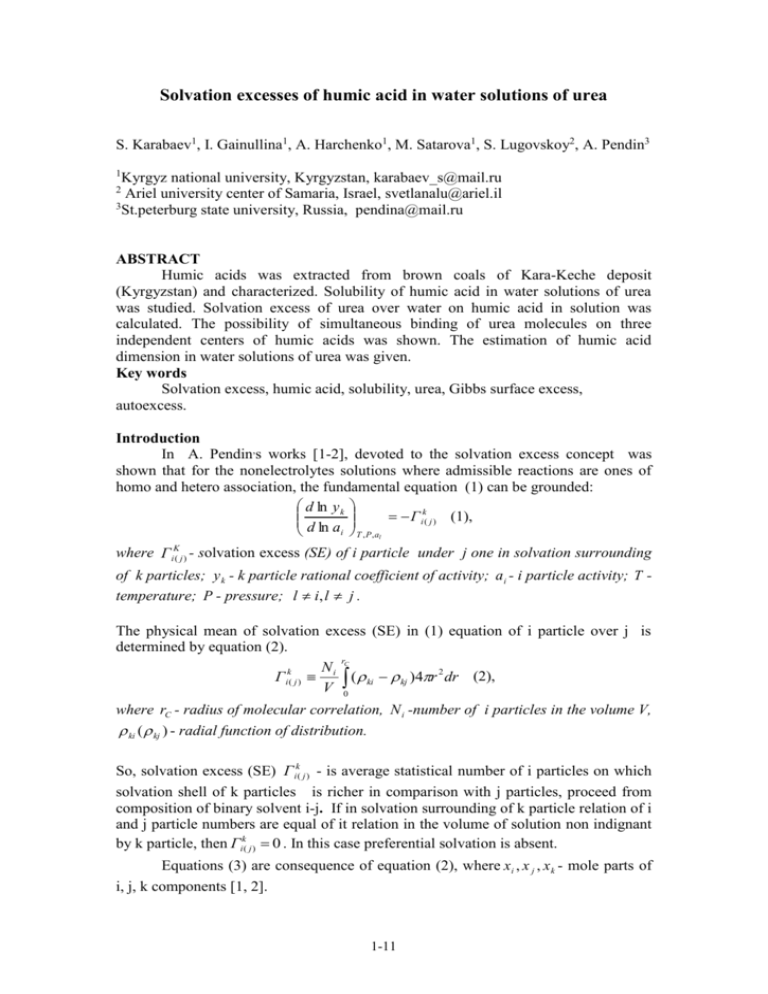
Solvation excesses of humic acid in water solutions of urea S. Karabaev1, I. Gainullina1, А. Harchenko1, M. Satarova1, S. Lugovskoy2, А. Pendin3 1 Kyrgyz national university, Kyrgyzstan, karabaev_s@mail.ru Ariel university center of Samaria, Israel, svetlanalu@ariel.il 3 St.peterburg state university, Russia, pendina@mail.ru 2 ABSTRACT Humic acids was extracted from brown coals of Kara-Keche deposit (Kyrgyzstan) and characterized. Solubility of humic acid in water solutions of urea was studied. Solvation excess of urea over water on humic acid in solution was calculated. The possibility of simultaneous binding of urea molecules on three independent centers of humic acids was shown. The estimation of humic acid dimension in water solutions of urea was given. Key words Solvation excess, humic acid, solubility, urea, Gibbs surface excess, autoexcess. Introduction In A. Pendin,s works [1-2], devoted to the solvation excess concept was shown that for the nonelectrolytes solutions where admissible reactions are ones of homo and hetero association, the fundamental equation (1) can be grounded: d ln y k Г ik( j ) (1), d ln ai T , P ,a l where Г K i( j) - solvation excess (SE) of i particle under j one in solvation surrounding of k particles; y k - k particle rational coefficient of activity; a i - i particle activity; T temperature; P - pressure; l i, l j . The physical mean of solvation excess (SE) in (1) equation of i particle over j is determined by equation (2). r Ni C k Г i( j) ( ki kj )4r 2 dr (2), V 0 where rC - radius of molecular correlation, N i -number of i particles in the volume V, ki ( kj ) - radial function of distribution. So, solvation excess (SE) Г ik( j ) - is average statistical number of i particles on which solvation shell of k particles is richer in comparison with j particles, proceed from composition of binary solvent i-j. If in solvation surrounding of k particle relation of i and j particle numbers are equal of it relation in the volume of solution non indignant by k particle, then Гik( j ) 0 . In this case preferential solvation is absent. Equations (3) are consequence of equation (2), where xi , x j , x k - mole parts of i, j, k components [1, 2]. 1-11 l Xi K Xi K K K Г j (l ) ; X K Г iK( j ) 0 (3) Г Г j (i ) ; Г i ( j ) Г i (l ) Xj Xj K 1 Existence of binding equations (3) result in that in binary system from for solvation excesses only one independent, in three component system from eighteen excesses only for excesses are independent. Range of permissible values of Г ik( j ) is determined by conditions of stability of concentration changes [2]. Concept of solvation excess was successfully used for description of preferential solvation in usual multicomponent liquid solutions [3-5]. At the same time solvation excess Г ik( j ) is analog of Gibbs adsorption in the phase volume. It can be used for description of preferential solvation effects in solutions of natural biopolymers, when notion of molecule transforms in molecular ensemble. In according with this, the aim of our work is studying of preferential solvation of humic acid (gk) in water solutions of urea (s). Equations (4) and (5) can be written in accordance with equations (1) and (3) for research system: lg YW w s (Г w(s) Г s(w) ) (4) lg aW T , P K i( j) lg Ygk0 x w gk Г gk Г s(w) (5) w(s) xs lg aW T , P ,agk where Г ww ( s(Г) ss ( w) -) autoexcesses in binary solvent water-urea, Ygk0 - limiting coefficient of activity of humic acid in water solution of urea , Ygk0 1 at a w 1 (Mole dole of urea x s 0 ). Experiment Humic acid was extracted from analytical test of brown coal (Kara-Keche deposit, Kyrgyzstan) using method of Orlov [6]. Dimensions of coal particles were about 60 mesh. According to methodic coal was decalcinated to release of calcium ions, which form with humic acid difficult solving humats. Humic substances were extracted from decalcinated analytical test of coal using 0.1 M solution of NaOH. For this purpose mixture was mixed during 15-20 minutes on rotator, after that suspension was settled during 24 hours. Dark colored alkaline solution was separated of coal by decantation and centrifugation (4000 rotations in a minute). The obtained alkaline extract was acidified to pH =1-2 using concentrated sulfuric acid to coagulation of humic and himatomelanic acids. Washed out with distilled water precipitate were washed by ethanol for separation of himatomelanic acids. The precipitated humic acid was recrystallized and dried. Set of physico-chemical characteristics of humic acid was defined for establishment of its classification signs. Infrared spectra of analytical test of humic acid from Kara-Keche coal was measured on spectrometer «Nicolett Avvator» in spectral range of 4000-400 сm-1 in standard KBr based tablets. As it can be seen from Fig.1 IR spectra of humic acid has a band having a sharp maxima at 3418 cm-1caused by valent vibrations of OH groups of water, binding with intermolecular hydrogen bonds. Band at 1610cm-1 is related to deformation vibrations of OH groups of water. Duplet of weak intensity at 2923 and 2852 cm-1 is caused by valent vibrations of СН, –СН2–and –СН3 moieties. Bands having some unclear maxima at 1384 and 694 cm-1 are related to deformational vibrations of these groups. Absorption of –СОО- ion is observed at 1400-1380 сm-1. 1-12 Bend in the range about 1500-1400 cm-1 can be explained by presence of –СОО- ion in the simple. Possibly valent vibrations of –С=С- aromatic and aliphatic structures, including conjugated with С=О groups, can influence on absorption in the range 1700-1500 сm-1. Deformation vibrations of ОН groups in water and NH in amines are observed at the same range. Bands having maxima at 2348 and 2283 cm-1 are related to the valent vibrations of NH 2 and -С≡N groups. Band having maxima at 1245 cm-1 is related to the valent vibrations of С-О in carboxyl groups. Maxima in region of 1200 – 1050, 950-900 сm-1 are related to the deformational vibrations of alcohols groups –ОН. However, triplet at the same range of spectra having maxima at 1098, 1031 and 1007 сm-1 is caused by valent vibrations of Si-O groups, characterizing minerals of caolinit group. It is confirmed by maxima at 754 сm-1, related to the deformational vibrations of these groups. Band with maxima at 911сm1 is also related to the deformational vibrations of О-Н groups of alcohols and to the deformational vibrations of Ме…ОН…О, band at 532 сm-1 is assigned to vibrations of Si-O-Me. In IR-spectra of humic acid, bands lying in the range 469 – 411 сm-1 are characterized by different sulfur- and halogen containing groups, which are minor in composition of humic acid. Fig.1 IR-spectra of humic acid from Kara-Keche Moist ( W a ), ash content ( A a ), element composition ( С а , H а , N a , О а , S а ) of analytical test of humic acid from Kara-Keche coal were defined using methodic [7]. Analysis of experimental data is based on statement that mass of humic acid simple adds from mass of organic (CNSO) and inorganic (ash content, hygroscopic water) parts. Average arithmetical data of several parallel results are presented in tabl.1. 1-13 Table1 Ash content, moist, element composition of humic acid from Kara-Keche coal for analytical test of humic acid С а ,% 60,60 С Г ,% 70,90 Nа, % О а ,% W a ,% S а ,% H а ,% 3,44 1,04 0,94 19,65 3,63 In calculation on arid, ash discharge mass of humic acid H S Г ,% N Г ,% О Г ,% H Г ,% C 3,56 1,22 1,10 23,22 0,60 A a ,% 10,70 O C 0,25 Comparison of data of Fig. 1 and tabl. 1 with results of works [8, 9] and analysis of Van-Krevelen diagrams for atomic relations allow us to assume that studying simple of humic acid from Kara-Keche coal corresponds to the complex of typical signs of molecular ensemble with maximal contents of aromatic carbon (70%) and practically full absence of sugar fragments. Obviously, character of solubility of humic acid from Kara-Keche coal in water solutions of urea is conditioned by presence of hydrophobic polycondensing structures. Isothermal saturation of water solutions of urea by studying simple of humic acid from Kara-Keche was carried out at Т=2980К and continuous mixing during 24 hours. Phases were separated by centrifugation at 4000 rotations in minute. Solubility sat. of humic acid ( CGK ) in water solutions of urea was determined by spectrophotometer at the wave length 400 nm . E-value of humic acid in water solutions of urea is Е 22,9 л г 1см 1 , l 1. Results of experimental data of solubility are presented in tabl. 2. Table 2 Solubility and limiting coefficient of activity of humic acid in water solutions of urea (s) at T 298 0 K xs 0 0,0026 0,0052 0,0079 0,0106 0,0134 C gk (г / л) 0,00241 0,00247 0,00285 0,00296 0,00297 0,00302 Г s ( w) 1010 0 -0,04 -0,09 -0,14 -0,18 -0,24 lg YW lg aW 0,00000 0,00016 0,00031 0,00047 0,00063 0,00079 0,00000 -0,00097 -0,00195 -0,00297 -0,00400 -0,00507 lg Ygk0 0,0000 -0,0107 -0,0728 -0,0893 -0,0908 -0,0980 Quantities of lg Ygk0 in water solutions of urea (tabl.2) were calculated by equation (6). lg Ygk0 lg C gk ( w) (6) C gk ( s ) Values of logarithms of activities (a w ) and coefficients of activity (Yw ) of water in water solutions of urea and values of Gibbs relative surface excesses of urea over water ( Г s (w) ) were taken in the work [5]. 1-14 Results and discussion Data of tabl.2 are the basis of calculations of autoexcesses in binary solvent and solvation excesses of humic acid in water solutions of urea by equations (4) and (5). For this purpose dependences lg YW = f( lg aW ), lg Ygk0 = f( lg aW ) were described by polynoms with following analytical differentiation. As it can be seen from Fig.2 urea, having bipolar nature in water solutions, is surface-nonactive component, because values of Г s ( w) 0 (curve 3). At the same time, weak homoassociation of binary solvent components takes place in water solutions of urea, as calculated values of autoexcesses are positive Г ss( w) Г ww( s ) 0 (curve 2). As it can be seen from Fig.2 solvation excess of urea over water on humic acid is positive Г sgk( w) 0 (curve 1) and more than Г ss( w) Г ww( s ) . This result testifies the preferential concentration of micro non homogeneities of binary solvent, enriched by urea, on humic acid. So, surface- nonactive urea is solvatoactive to humic acid in water solution. It is obvious, that it is explained by inter molecular interactions of urea with reaction centers of molecular ensemble of humic acid. Fig.2 Solvation and surface excesses in the system water-urea-humic acid at 2980К 1- solvation excess of urea over water on humic acid( Г sgk( w) ); 2-autoexcess in water solution of urea ( Г ss( w) Г ww( s ) ); 3-relative surface excess of Gibbs on the border water solution of urea – steam ( Г s ( w) 1010 ). For definition of urea molecules number, simultaneously binding with humic acid from Kara-Keche coal, analysis of values of solvation excesses Г sgk( w) was carried out in coordinates of Scetcherd plot and within the frames of Hill,s semi empirical method [10]. Results of this examination are presented in the Fig.3. 1-15 Fig.3. Hill,s plot of solvation excess of humic acid in the water solution of urea at 2980К As it can be seen from Fig.3 Hill,s coefficient ( H ) is equal to unit. It is explained by binding of urea molecules on three independent centers of studied simple of humic acid from Kara-Keche coals. So far as constant of humic acid association with three molecules of urea is not big (К=6,3), we can consider that energy of biopolymer interaction with components of binary solvents is smaller than among particles of solvent. In this case phenomenological relation between solvent ( Г sgk( w) ) and surface ( Г s (w) ) excesses can be written as equation (7) [4]. P gk Г sgk( w) 4rgk2 N A Г s(w) 1Г s(w) (rgk ) 2 Г s(w) (7) The first number ( 4rgk2 N A Г s(w) ) of equation (7) is the solvation excess of surfaceactive component of binary solvent on the surface of cavity ( rP ). Radius of this cavity is equal to radius of humic acid in the water solution of urea ( rgk ). The first correction P gk 1Г s(w) (rgk ) accounts the crookedness of this cavity. The second correction 2 Г s(w) accounts the contribution of intermolecular interactions of humic acid with urea in the value of Г sgk( w) at the bringing of biopolymer in cavity. According to Tolmen [11] at P rP rgk , 1Г s(w) (rgk ) 0 . At the same time, the value of second correction can be gk equal to three molecules of urea, simultaneously related with humic acid 2 Г s(w) 3. So, equation (7) can be written as equation (8) rgk gk (Г s(w) 3) 4 N A Г s(w) (8) Results, carried out by equation (8) are presented in the Fig.4. 1-16 Fig. 4. Radius of humic acid ( rgk ) as function of composition of water solution of urea( X S ) at 2980К As it can be seen from Fig. 4 radius of humic acid monotonously decreases from 310 to 120 nanometers with increasing of urea mole part in the interval 0,0014 X S 0,0134 . It is observed the antibat dependence of Г sgk( w) from binary solvent composition (Fig. 4). Possibly it is related with micelle nature of macro molecular (humic acid) in the water solution of low molecular bipolar ligand. Increasing of concentration of this ligand lead to increasing of dielectric penetration of binary solvent. References 1. Pendin A.A. Preferential solvation in three- and multycomponent liquid solutions // Journal of physical chemistry. – 1985. -№9. – P. 2193 2. Pendin A.A. Preferential solvation and thermodynamical properties of nonelectrolytes solution // Journal of physical chemistry. –1989. - № 7. – P. 1793 3. Pendin A.A., Karabaev S.O., Susareva O.M. Preferential solvation of ferrocen in two- component polar solvents // Journal of physical chemistry. – 1987. –V. LXI. – N 4. – P. 972 4. Pendin A.A., Vasileva L.G., Karabaev S.O., Susareva O.M. Influence of intermolecular interactions of ferrocen in two-component solvents on the characteristics of it preferential solvation // Journal of physical chemistry. –– 1990. – V. 64. – N 4. – P. 935 5. Karabaev S.O., Pendin A.A. Effects of ions and nonelectrolytes preferential solvation in binary solvents. .-B: KSNU, 2001. - 121 p. 6. Orlov D.C. Chemistry of soils. – M.: МSU, 1992. – 259p. 7. Klimova V.A. Basis micro methods of organic compounds analysis. - М.: Chemistry, 1975. – 219 p. 8. Perminova I.V. Analysis, classification and prognosis of humic acid properties. / Diss. on reception of scientific degree of doctor of chemical sciences – М.: МSU, 2000. – 359p. 9. Nazarova N.I., Alybakov N.K. Coals of Kyrgyzstan and composition of its humic acids. –Frunze: Ilim, 1976. – 103p. 10. Edsoll Dj., Gatfrend H. Biothermodynamic. M.: Mir, 1986.-291p. 11. Adamson A. Physical chemistry of surfaces. M.: Mir, 1979. -568p. 1-17 1-18
